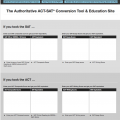Students submitting ACT scores to Georgetown University this year could have been at an admissions disadvantage relative to those submitting results from the new or “redesigned” SAT, according to a statement made last week by Dean of Undergraduate Admissions Charles Deacon.
“A lot of people are advised by their high school counselors maybe to take the ACT, which we don’t think is great advice,” said Deacon in an interview published by The Hoya, Georgetown’s student-run newspaper, in reference to testing strategies used by applicants for fall 2017 admission.
Why would that be? Because Dean Deacon believes, based on what he heard from the College Board, that scores from the redesigned SAT appear higher than those from either the old SAT or the ACT.
And he’s right—sort of. But there’s a reason. In fact, there are several reasons why the scores are higher, including that it’s an entirely different test.
While rumors have circulated for years about Georgetown’s alleged preference for College Board products, this is the first time a statement seeming to confirm the bias has appeared in print. And it comes in the context of transitioning from the “old” SAT, last given in January, 2016, to the redesigned SAT, which debuted in March, 2016.
During the transition to the new test, a large number of students planning to apply for fall 2017 opted to take the ACT, to avoid what appeared to be a significant number of unknowns in content and scoring for the new SAT. Still others took the old SAT for some of the same reasons.
And many took various permutations and combinations of the three tests. But for Georgetown, it seems that students submitting the new SAT might have had an advantage over those submitting only the old SAT or the ACT.
Once initial scores from the new SAT came in and were analyzed by the College Board, a conversion tool was devised and posted online that compared those scores with those from the older test and the ACT.
While the ACT initially protested that the concordance was completed without sufficient study, the resulting comparisons made it clear that students taking the new test were coming in with numerically higher scores than in the past. It didn’t mean they necessarily did better and could look forward to applying to more selective schools. It simply meant the numbers were higher and a translating tool between the old and new tests was necessary to compare applicants.
As a result, a number of test prep organizations and individual colleges devised detailed tables designed to facilitate these comparisons. Princeton Review distributed a quick SAT-ACT comparison table as a bookmark for counselors to keep at their desks. Compass Prep compiled and published “estimated” new SAT score ranges for 360 popular colleges and universities, using most-recently reported old SAT scores translated via concordance into new SAT scores.
According to this translation, Georgetown went from a published midrange of 1320-1500 for the old SAT to an estimated midrange of 1390-1560 for the new SAT. In other words, students taking the new SAT would have to score higher to stay within Georgetown’s most recent 25th-75th percentile of entering freshmen.
But Georgetown evidently didn’t look at it that way. A counselor newsletter circulated last fall said, “We do not plan to use the College Board’s concordance tables to adjust SAT I scores in either direction.” This policy was recently confirmed by a representative from the Georgetown admissions office.
Instead, admissions readers were asked to look at scores “contextually” and without a tool to facilitate comparisons among applicants submitting different tests.
At the same time, The Hoya reported Deacon as noting that Georgetown saw an increased number of students taking and submitting scores for the ACT that looked “lower” when compared to the new, inflated SAT scores. “Deacon said this trend could have hurt students who preferred to submit ACT scores instead of the new SAT scores they received because they considered it to look more impressive.”
Reacting to concerns about any disadvantage suffered by students submitting the ACT only, Dean Deacon, speaking through a representative, said he was concerned that students “traditionally preparing” for the SAT were interrupted in their preparations by counselors who encouraged them to switch to the ACT, and this may have produced lower scores.
In other words, he felt that any harm done was a result of switching tests and not a result of any Georgetown bias produced by failing to recognize the new scale and use concordance tables to translate scores from one test to the other.
James Murphy, the Director of National Outreach for The Princeton Review disagrees, “The decision to treat the new SAT scores as if they are equivalent to the old test is a misuse of the exam, and College Board would be the first to say so. It almost certainly hurt students who applied to Georgetown.”
Georgetown is still working on compiling numbers for the Class of 2021, and admissions results will be mailed by the end of this week.




